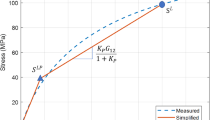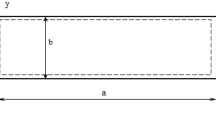Abstract
In this paper, a method is proposed for calculating the bearing capacity of composite reinforced wing box panels under compression after impact, which has improved calculation accuracy and accelerated analysis time. The paper describes a method for two-phase calculation of the bearing capacity of reinforced panels, taking into account defects, based on the transfer of the stress–strain state from the global model to the local one. To implement the method, a discrete finite element mesh of the study area and a local model of the reinforced skin are created. The method of two-phase analysis of the bearing capacity of reinforced skins with applied impact defects consists of two main components. The first phase is a static calculation of the global shell model of the entire structure under critical loading conditions—the design case that takes place during the flight of the aircraft at small positive angles of attack, in which the aircraft realizes the maximum lift and torque for a given aircraft. In the second phase, a detailed local solid model of the studied area of the reinforced skin is prepared and a dynamic impact analysis is performed. Next, compressive force flows or displacements are transferred from the global model to the closed contour of the local zone and a solution is made in a dynamic or static formulation. This article presents the developed method of global–local modeling, which makes it possible to analyze the bearing capacity of reinforced skin after impact with a more detailed grid without sampling the global model, which speeds up and refines the calculation.

















Similar content being viewed by others
Data availability
Not applicable.
Code availability
Not applicable.
References
Pogosyan M, Nazarov E, Bolshikh A, Korolskii V, Turbin N, Shramko K (2020) Aircraft composite structures integrated approach: a review. J of Physics. https://doi.org/10.1088/1742-6596/1925/1/0/012005
Barricelli B, Casiraghi E, Fogli D (2019) A Survey on digital twin: definitions, characteristics, applications, and design implications. IEEE Access 7:19143996. https://doi.org/10.1109/ACCESS.2019.2953499
Alam, M. Crack (2016) Penetration and deflection behavior at interfaces, Ph. D. dissertation. Oregon state university. USA, Corvallis OR, p 77
Mitrofanov OV, Pavelko IV, Konstantinov VA, Esaulenko AV (2018) Features of the methodology of designing load-bearing panels of composite materials in compression considering the damage from shock influences. Nat Techl Sci 1(115):109–112
Smith M (2014) ABAQUS/Standard User’s Manual, Version 6.14. Dassault Systèmes Simulia Corp, Providence, RI
Lopes C, Gurdal Z, Camanhoz P.P, Gonzalez E.V, (2009)"Simulation of Low-Velocity Impact Damage on Composite Laminates," Structures, Structural Dynamics, and Materials Conference,.
Sih GC, Cha BCK (1974) "A fracture criterion for three-dimensional crack problems. J Eng Fract Mech. 6:1974
Chepurnikh IV (2013) Structural strength of aircraft: a textbook. KSTU, Komsomolsk-on-Amur
Easy Access Rules for Large Aeroplanes (CS-25) (Amendment 26), European Union Aviation Safety Agency (2021). https://www.easa.europa.eu/en/document-library/easy-access-rules/easy-access-rules-large-aeroplanes-cs-25/
Sung N, Suh N (1979) "effect of fiber orientation on friction and wear of fiber reinforced polymeric composites. Wear 53:129–141
Dou W, Zhang L, Chen G, Stichel S (2020) "A boundary-condition-transfer method for shell-to-solid submodeling and its application in high-speed trains. Int J of Mech Sci. 177:105542
Citarella R, Cricrì G (2014) Three-dimensional BEM and FEM submodelling in a cracked FML full scale aeronautic panel. Appl Compos Mater 21:557–577
Citarella R, Giannella V, Vivo E (2016) FEM-DBEM approach for crack propagation in a low pressure aeroengine turbine vane segment. Theor Appl Fract Mech 86:143–152
Zhao C, Lavasan AA, Schanz T (2019) Application of submodeling technique in numerical modeling of mechanized tunnel excavation. Int J Civil Eng. 17:75–89
Sinchuk Y, Pannier Y, Gueguen M (2018) Image-based modeling of moisture-induced swelling and stress in 2D textile composite materials using a global-local approach. Proceed Inst Mech Eng Part C-J, Mech Eng Sci. 232(8):1505–1519
Kim SM, Kim JG, Park KC (2018) A component mode selection method based on a consistent perturbation expansion of interface displacement. Comput Methods Appl Mech Eng 330:578–597
Bonisoli E, Delprete C, Rosso C (2009) Proposal of a modal-geometrical-based master nodes selection criterion in modal analysis. Mech Syst Signal Process 23(3):606–620
Mitrofanov O, Shkurin M (2023) "Design of load-bearing anisotropic wing box panels ensuring static strength in the post-buckling state. Aerosp Syst. https://doi.org/10.1007/s42401-023-00193-x
Dutta D (2016) "Rate of energy release and crack initiation directions for laminated composites. J Mechl Behav Mater 25:1–2
Dolgikh DA, Tashkinov MA (2020) Investigation of damage accumulation and delamination propagation in polymer composite materials based on two-level fracture models. PNRPU Mech Bullet 2020(4):74–85
Benzeggagh ML, Kenane M (1996) Measurement of mixed-mode delamination fracture toughness of unidirectional glass/epoxy composites with mixed-mode bending apparatus. Comp Sci Technol 56:439–449
Mitrofanov O, Osman M (2022) "Design of thin orthotropic panels according to the postbuckling state under combined loading taking into account uniform heating. Aerosp Sysyt 5:29–36. https://doi.org/10.1007/s42401-021-00129-3
ABAQUS/Explicit: Advanced Topics (2005). https://www.3ds.com/products-services/simulia/training/course-descriptions/abaqusexplicit-advanced-topics/
Funding
Not applicable.
Author information
Authors and Affiliations
Corresponding author
Ethics declarations
Conflict of interest
Not applicable.
Rights and permissions
Springer Nature or its licensor (e.g. a society or other partner) holds exclusive rights to this article under a publishing agreement with the author(s) or other rightsholder(s); author self-archiving of the accepted manuscript version of this article is solely governed by the terms of such publishing agreement and applicable law.
About this article
Cite this article
Bolshikh, A., Borovkov, D. & Ustinov, B. Investigation of the local area damage influence on the load-bearing capacity of the reinforced composite panels. AS 7, 43–55 (2024). https://doi.org/10.1007/s42401-023-00214-9
Received:
Revised:
Accepted:
Published:
Issue Date:
DOI: https://doi.org/10.1007/s42401-023-00214-9




